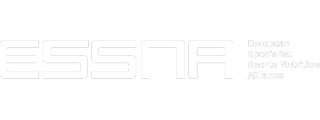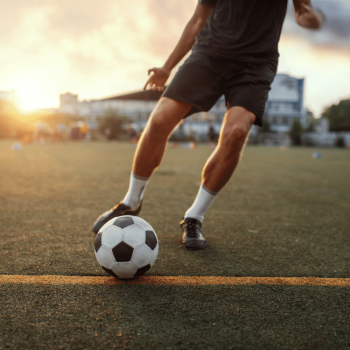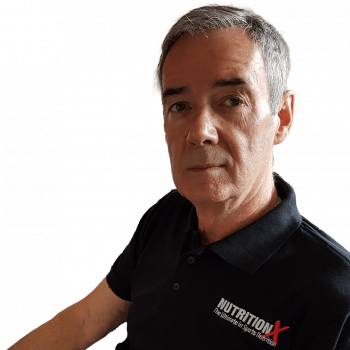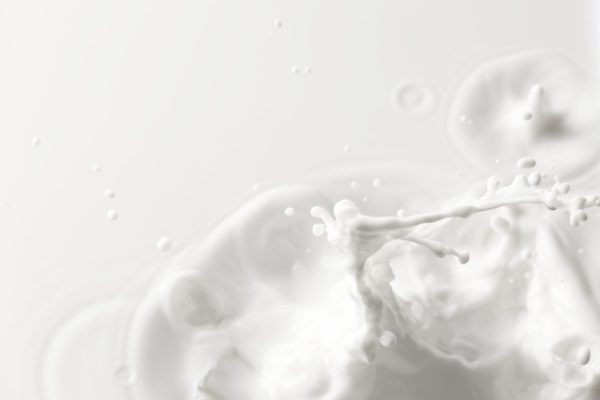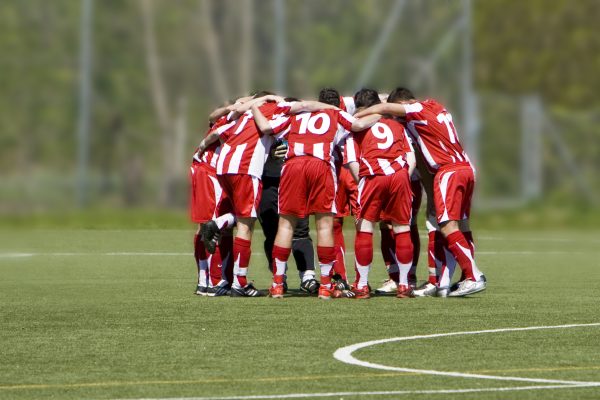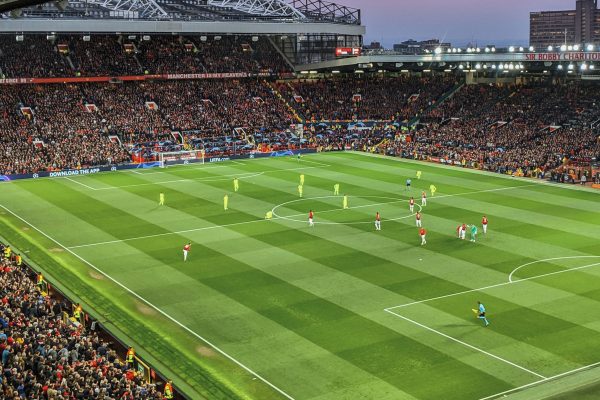Ahead of the International Football Tournament, we dive into the latest research on the role of nutrition for professional football athletes. This article, co-written by Andrew Hulton, James Malone, Neil Clarke and Don Maclaren, offers the athlete and practitioner valuable and practical insight into nutrition for the football player.
Read the full X-Change article here or download the PDF via the button below.
Practical Implications
- Soccer match-play and training makes significant demands on both the anaerobic and aerobic energy systems
- Carbohydrate (CHO) is a crucial energy source for performance and may be substantially depleted in muscle and liver
- Fatigue in soccer is likely to result from depletion of CHO sources
- Maintenance of muscle and blood CHO levels are desirable
- CHO intake should be matched with the likely demands placed on this energy reserve
- Protein consumption should be ~1.6-2g/kg/day, and this is best achieved by regular intake of protein sources at each meal/snack
- Increased CHO intake is necessary on the day before a match (or heavy training) as well as match days, whereas a reduced intake is desirable on light training days
- The pre-match meal must contain good sources of CHO, easily digested protein and fluid
- Strategies for what to eat after the pre-match meal, during match-play and after a match are provided
Introduction
Soccer is a highly demanding intermittent sport that involves fluctuations between low and high intensity activities (Bangsbo, 1994). At the professional level, male soccer players typically cover around 11-13 km per match dependent on position, with central midfielders covering the highest and central defenders the lowest distances (Bradley et al., 2009). Of the overall distance covered, around 1150m is run at speeds above 20 km.h-1, with about 60 sprints performed; this is again dependent on the positional role (Barnes et al., 2014). Overall,, players perform more than 1200 unpredictable changes in activity, which also comprises of ~700 turns and 30-40 tackles and jumps (Bloomfield et al., 2007). Further, Mohr and colleagues (2003) observed significant reductions in the amount of both total and high intensity distance covered towards the last 15 minutes of match play compared to the initial 15-minute period, with players encountering temporary reductions in physical output following the most demanding 5-minute period during match-play (Mohr et al., 2003). In training, soccer players typically cover around 3-7 km, with around 100-600m and 50-400m covered above 20 km.h-1 and 25 km-1, respectively, dependent on the training day relative to the next match (i.e. match day minus; MD-) (Malone et al., 2015). Soccer coaches normally periodise the overall loading during training microcycles in order to load the player early in the training week, followed by a reduction in load as a form of taper to dissipate fatigue whilst aiming to maximise adaptation processes (Clemente et al., 2019).
From an energy perspective, soccer places significant demand on both the aerobic and anaerobic systems in order to perform at the highest level (Iaia et al., 2009). Soccer match-play elicits average and peak heart rates of ~85 and ~98% of maximal values, respectively (Krustrup et al., 2005), and such data suggests that the average oxygen uptake is around ~70% V̇O2max (Bangsbo et al., 2006). Since approximately ~90% of match-play is performed at low to moderate intensity (Bangsbo, 2014), the aerobic energy system provides most of the energy, with a focus being on recovery between bouts of high intensity activity. High intensity activities, such as accelerations and jumping, require use of energy from the anaerobic systems (Bangsbo, 2014). These high intensity actions often lead to crucial moments of match-play, such as straight-line sprinting within goal scoring situations (Faude et al., 2012), and result in elevated levels of lactic acid which are typically 2-12 mM during soccer matches (Krustrup et al., 2006), although it should be noted that these values are highly influenced by the preceding five minutes of activity. Since anaerobic glycolysis as well as carbohydrate (CHO) oxidation are important sources of energy, muscle glycogen has been found to be depleted following match-play to around 43% of pre-match levels and remains significantly reduced up to and beyond 24h hours post-match (Krustrup et al., 2011). Thus, soccer players are required to be adequately prepared from both a training and nutritional perspective to meet the energy requirements.
The aim of this article is to analyse the available scientific literature concerning the energy intake in soccer with a view to suggesting some practical guidelines. The objective is to provide evidence-based nutritional strategies for practitioners to implement in order to optimise soccer performance. Consequently, exploration of the metabolic changes that take place during training and matches is examined before attention is given to the nutritional needs of players. The reader should be aware that this article is a truncated version of a more comprehensive review paper published recently (Hulton et al., 2022).
Fatigue and soccer
Fatigue, as defined by the inability to sustain the necessary speed or power output, in soccer has received much interest within the literature since it is important in the outcome of matches. Reilly (1996) suggested the presence of fatigue could be realised in the increases in goals scored in the final 10 minutes of matches, although fatigue can occur at different stages throughout a match, with temporal fatigue present after intense periods of the game and attributed to disturbances in muscle ion homeostasis (Mohr et al., 2003), or more permanent fatigue identified towards the end of match play. Though there are many potential mechanisms responsible, two of the main explanations which have a nutritional implication are a depletion of muscle glycogen and hypoglycaemia (Mujika & Burke, 2010). Investigations from the early 1970’s (Saltin, 1972) first demonstrated that players starting a soccer match with low muscle glycogen availability fully deplete their stores by the end of the match. In fact, low muscle glycogen was observed at half-time in these players, resulting in an early onset of fatigue characterised by a significant increase in time spent at low intensity movement such as walking (50% vs 27% of total distance), and an inability to complete sprinting activities (15% vs 24% of total distance) compared to those who started the match with ‘normal’ glycogen availability. A comparable investigation by Krustrup et al. (2006) demonstrated a gradual reduction in muscle glycogen throughout a soccer match in Danish fourth division players during non-competitive matches. Although total muscle glycogen was not fully depleted, approximately 47% of all muscle fibres were described as ‘depleted or almost depleted of glycogen’. Fibre type analysis identified that depletion was apparent within type IIa (intermediate) and type IIx (fast) fibres, which are responsible for high intensity actions, and as such may support the significant reduction in sprinting performance observed throughout the match. It would be prudent to note that this investigation was not conducted on elite players, who are engaged in more high intensity activities (Mohr et al., 2005), and so result in greater glycogen depletion. Many investigations assessing glycogen use in soccer match play or simulated game activity highlight the need for optimal glycogen storage prior to kick-off for optimal performance.
Reductions in blood glucose concentrations due to inadequate CHO availability invariably lead to hypoglycaemia, since once liver glycogen is depleted, there is an inability to produce sufficient glucose for circulation from the lower rates of liver gluconeogenesis. Since the brain primarily uses glucose from the blood as an energy source, hypoglycaemia has been considered a factor contributing to fatigue. Early laboratory studies conducted by Christensen & Hansen (1939) clearly demonstrated this point. Consequently, hypoglycaemia may be identified as a nutritional factor that may produce fatigue or suboptimal performance in soccer (Mujika & Burke, 2010). The mechanism for any decrement in performance due to hypoglycaemia has been attributed to affecting skill and running capacity. Currell et al. (2009) observed that the ability to dribble a ball around cones at various time points during soccer simulated activity was demonstrably slower with placebo compared with ingestion of CHO. In addition, further investigations have observed improvements in specific soccer skills (Ali et al., 2007) and perceived activation/arousal when CHO is ingested (Backhouse et al., 2007). In these investigations, hypoglycaemia was not evident (in placebo trials), and indeed to date no studies have reported hypoglycaemia during a soccer match or in simulated studies within a laboratory context. Could it be that higher levels of blood glucose during the simulated soccer performance with glucose ingestion results in the greater performance of skilled based tasks and perception? Clearly more studies are required to address this issue. Current nutritional strategies are to consume CHO in the hours before and during match play, thus making the appearance of hypoglycaemia relatively rare during soccer (Ekblom, 1986). In addition, during extended periods of play, such as extra time, research has demonstrated that euglycaemia can be maintained beyond the 90 minutes (Harper et al., 2015).
Nutritional intake and soccer
In order to provide evidence-based nutritional guidelines, it is important to first establish the dietary habits of soccer players across different sessions (e.g. training sessions, matches and rest days). In terms of energy intake (EI), players consume around ~2200 – 3000 kcal/day during training days (Brinkmans et al., 2019). Furthermore, when factoring in both training and match days combined across the sampling period, this value increases to around ~3100 – 3900 kcal/day. On non-training days (i.e. rest days), EI has been reported to be ~2510 kcal/day (Brinkmans et al., 2019). Jacobs and colleagues (1982) also reported high EI of ~4900 kcal/day on the day following match-play in Swedish professional players. In the studies that have directed compared energy balance through EI and energy expenditure (EE), a negative energy balance of around ~200 – 500 kcal/day across training and match-play combined is observed (Anderson et al., 2017). This may be due to players wanting to limit any increases in body fat during the competitive season, which is seen as a negative factor by both players and coaching staff. Having identified the link with fatigue and pre match glycogen stores, clear evidence has emerged that indicate sa periodised approach to CHO feeding during weekly training in preparation for competition. It is clear from a recent investigation within the English Premier League (Anderson et al., 2017), albeit with only six players, that CHO intake increases on match day to 6.4g/kg compared with a training day CHO intake of 4.2g/kg. These findings confirm the group's previous work on training and match loads (Anderson et al., 2016), which supports the implementation of a periodised CHO feeding strategy to support physical output and dietary planning. Similar nutritional results, with a much larger sample of professional players from the Dutch Eredivisie (Brinkmans et al., 2019), support the observation of a periodised CHO approach with a significant increase on match day (5.1g/kg) compared to training days (3.9g/kg) and rest days (3.7g/kg). Such a periodised approach to CHO intake is matched by the overall EI of English Premier League players with higher match day EI of 3789 kcal compared to training day EI of 2956 kcal. Findings reported for the Dutch Eredivisie are 3114 kcal, 2637 kcal and 2510 kcal for match day, training days and rest days respectively.
In the studies reported above, protein did not differ statistically throughout the competitive week in either the English or Dutch players, although a notable observation was the high protein intake observed from the English players; which in relative terms amounts to a daily protein intake of 2.4g/day. Observations from the Dutch players (Brinkmans et al., 2019) and an earlier finding from two Scottish Premier league teams two decades previously (Maughan, 1997) demonstrated lower protein intakes of 1.7 g/kg for the Dutch players, and 1.3-1.4 g/kg for the Scottish teams. The protein intakes observed with the English players may be considered extreme in light of the view that intakes in excess of approximately 1.7 g/kg are unlikely to aid further muscle building or repair (Maughan & Shirreffs, 2007). These potentially excessive intakes of protein do not represent an issue for CHO intake of players unless the large protein intake replaces the CHO. These data provide further incentive to follow a periodised CHO intake and plan in accordance with seasonal fixtures to ensure CHO is not neglected.
In contrast to the senior players, academy players exhibit no significant differences in macronutrient intake across a training week consisting of four training days, two rest days and a match day (Briggs et al., 2015). These relatively stable intakes may suggest that academy players do not adjust dietary intake across the week to account for the varying intensity of training and matches. The mean CHO intake was 6.0g/kg, 5.6g/kg and 5.5g/kg for heavy training, moderate training and matches respectively. Protein intake followed the same pattern as senior players with a consistent intake throughout the week of 1.6g/kg, 1.4g/kg and 1.5g/kg for heavy training, moderate training and matches respectively; albeit these data illustrates an overall lower relative protein intake for academy players.
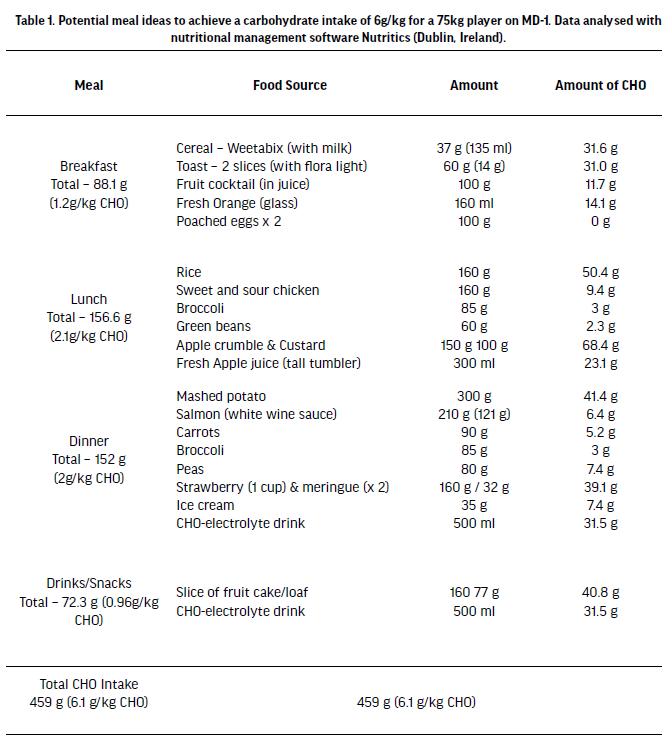
Nutrition for pre-match day (MD-1)
Support for high CHO strategies is routinely suggested for improved performance during simulated soccer activities (Bangsbo et al., 1992), small-sided games (Balsom et al., 1999) and match play (Souglis et al., 2013), with increased physical output evident throughout. Consequently, the primary nutritional focus for pre-match day, or matchday minus 1 (MD-1), is to ensure that both muscle and liver glycogen stores are optimally elevated in preparation for matchday endeavours. In terms of training, MD-1 usually focuses on light tactical work and brief activity at high intensity to maintain ‘sharpness’. Nutritionally, the emphasis is for an increase in CHO intake such that 6-8g/kg is consumed (Collins et al., 2021).
In order to achieve a CHO intake of 6 g/kg in MD-1 it is necessary to consume CHO at all opportunities. Table 1 illustrates what may be undertaken in order to attain such a goal for a 75kg player, where the CHO intake is likely to be 450g i.e. 6g/kg. It is useful to consider a 4 or 5 meal strategy for MD-1 i.e. breakfast, lunch, mid-afternoon snack, dinner and supper (the mid-afternoon or supper may not be suitable for all). With such a strategy it is quite possible to ingest 2 g/kg CHO at lunch and at dinner, around 1 g/kg for breakfast; the remaining CHO consumption (i.e. around 1g/kg) may be obtained via appropriate drinks and/or snacks in the afternoon or for supper. Since glycogen is stored with water, fluid consumption with each meal/snack is necessary.
Since high glycaemic index (HGI) foods are digested and absorbed more rapidly than low glycaemic index (LGI) alternatives, it is pertinent to consider consuming foods which have a high GI and may encourage greater intake. However, there is a lack of evidence in regard to whether high or low GI meals are advantageous for glycogen loading over a 24-h period. Burke et al. (1993) concluded that a HGI nutritional strategy should be followed as part of a recovery strategy following glycogen depleting exercise, with an approximate 50% difference between the variety of GI, but this investigation employed a training volume and intensity unlikely to be followed during MD-1 where the training load is normally light and therefore may not be applicable. More research is required in relation to GI carbohydrate intake during the MD-1. Having said that, it is prudent to allow players to consume carbohydrate sources they enjoy during MD-1 as long as there are sufficient amounts to achieve ~6g/kg.
Nutrition and match-day: pre-match
As highlighted above, MD-1 is vital for nutritional preparation for competition and may be more important than any meals on the match day itself. This is likely since it is not easy to replenish significant loss of muscle glycogen within a short period such as 24-h. Certainly, liver glycogen may be more rapidly replenished in a contracted period but not muscle glycogen. If an appropriate feeding strategy of high CHO is adhered to, match day itself should just be a ‘top up’ of muscle and replenishment of liver glycogen. Liver glycogen has been observed to decrease significantly following an overnight fast (Hson Nilsson, 1973), with total depletion expected after 36 hours. This means that approximately 33% of liver glycogen could be lost during an overnight fast of 12 hours, and up to 50% if no CHO is consumed until kick-off.
If muscle and liver glycogen is to be enhanced on match day, it is pertinent to examine the findings of Wee and colleagues (2005) who observed a 15% increase in muscle glycogen 3-h after ingestion of 2.5g.kg of a high GI breakfast but not from a low GI breakfast meal. Unfortunately, the authors did not assess liver glycogen storage. It is possible that liver glycogen stores would be promoted in both conditions since an earlier study by Casey et al. (2000) using magnetic resonance spectroscopy (MRS) demonstrated significant liver glycogen restoration after exercise when fed 1g/kg glucose or sucrose. In fact, sucrose ingestion resulted in a much higher amount of storage than glucose probably because sucrose contains fructose which has been established to enhance liver rather than muscle glycogen (Malone et al., 2021).
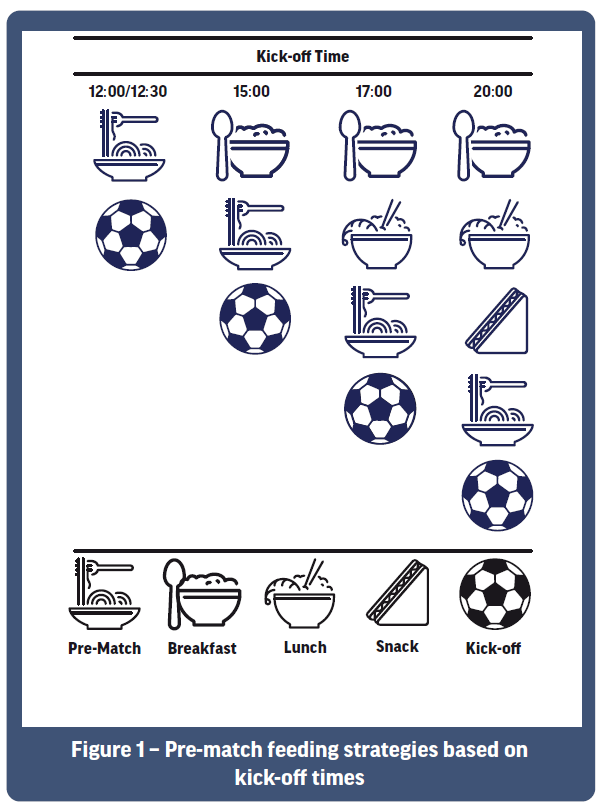
An issue over the last number of years is that kick- off time varies considerably in elite soccer, mainly due to the demands of television. Start times may be as early as 12:00 or 12:30 and as late as 20:00, although most matches in the UK have a 15:00 kick-off time. Clearly early kick-off times imply a single meal feed strategy whereas, for a 15:00 start, there is the possibility of a two-meal feed strategy, and for a 20:00 kick-off a three-meal feed strategy is desirable. For the earlier start times the importance of a sufficient CHO intake during MD-1 is paramount, whilst marginally less so for evening matches. Figure 1 highlights the possible scenarios for match day feeding strategies based on variations in start times.
The general consensus for pre-match nutrition would suggest a relatively high CHO meal of between 1–4 g/kg (Mujika & Burke, 2010) approximately 3–4 hours before kick-off. Low GI meals are thought to be more advantageous than HGI prior to exercise, mainly due the possibility that high GI meals could result in so-called rebound hypoglycaemia after about 3-4-h. The application of GI for sport and pre-exercise feeding was first studied in the early 1990s by Thomas et al. (1991) and concluded that LGI foods produced a greater endurance capacity compared to HGI foods, partly due to a potential glycogen sparing mechanism attributable to a more stable insulin and glucose profile. Further investigations supported this notion that LGI CHO foods improved capacity (Wong et al., 2008) and time trial performance (DeMarco et al., 1999), although these investigations were based around continuous exercise models. In contrast, soccer-specific investigations illustrated no difference between HGI and LGI pre-match foods (Little et al., 2009) or meals (Hulton et al., 2012), with the latter investigation following a more ecological protocol of match day timings, prior breakfast and realistic meals with all macronutrients present (details of meals presented in Table 2). Even though significant differences in postprandial glucose responses were observed, no metabolic or performance differences were observed (Hulton et al., 2012). Subsequently, muscle glycogen measurements were analysed following a further soccer-specific simulation to investigate glycogen utilisation differences between GI, and although a significant difference was observed between the control trial (fasted) and both HGI and LGI, no significant differences was seen between the fed trials (Little et al., 2010).
The concept of a high fat meal has also been investigated and compared to an isocaloric LGI meal prior to a soccer-specific simulation (Hulton et al., 2013). Results identify no performance benefits between the varying meals when muscle glycogen is adequate. Differences were observed between fat metabolites, substrate oxidation rates and subjective ratings of fullness and hunger, yet no transferable effect on performance or subjective rating of perceived exertion. It is important to note that prior to the soccer-specific investigations (Hulton et al., 2012; 2013), participants followed their habitual diet with a greater focus on CHO, signifying normal glycogen stores. Therefore, these results may advocate flexibility and a more personalised approach in the pre-match meal, rather than a prescribed meal or static menu, if a normal high CHO diet has been maintained throughout the training week. These may suit players as personal preferences can be maintained due to foods choices, cultural difference/choices, habits, rituals and/or superstitions.
Hydration is an important consideration since dehydration is a well-recognised fatigue factor in prolonged activities, and furthermore that water is required for glycogen storage. Consequently, players need to ensure they start the match in a euhydrated state. Evidence based on assessment of urinary parameters demonstrates that a large proportion of players may start competition in a relatively dehydrated state (Maughan & Shirreffs, 2007). Therefore, to ensure players are well prepared with regards to their fluid status, it is recommended that they slowly imbibe between 5 – 7 ml/kg at least 4-hours prior to the match (ACSM, 2007). From a practical perspective, the consumption of water is advisable during and after the pre-match meal,, up until arrival at the match venue. Use of carbohydrate-containing beverages should be discouraged after the meal and only be re-introduced after warm-up and in the 5–10-minute period before the match starts. This is to reduce the likelihood of rebound hypoglycaemia ensuing in the first 10-15 minutes of the match.
An inevitable consequence of undertaking any form of exercise such as soccer (training or match play) is that muscle protein breakdown (MPB) ensues, and that muscle protein synthesis (MPS) is attenuated (Phillips, 2014). It is also well established that feeding protein in the hour prior to engaging in such bouts of activity and in the 1 or 2 hours afterwards results in an increase in net protein balance, whereas no protein intake causes a deficit in net protein balance (Tipton et al., 2006). Consuming a pre-match meal with some protein (~20-30g) 3-h before is helpful, although it may be advisable to consider drinking some form of whey protein (without carbohydrate) an hour or so before kick-off. Such a proposal may help reduce MPB during the match, although no scientific data has been presented to date. The ingestion of a protein bar or protein shake is a useful consideration here.
One of the few supplements that has strong evidence for improving soccer performance is caffeine. Acute caffeine intake of a moderate dose of caffeine (3–6 mg/kg) 45 to 60 minutes before exercise has the capacity to improve several soccer-related abilities and skills such as vertical jump height, repeated sprint ability, running distances during a game and passing accuracy (Clarke et al., 2005). Data suggests that caffeine improves the physical and technical elements of performance that are required for successful soccer match play. Furthermore, the ingestion of 2-6 mg/kg body mass of caffeine has been reported to increase repeated sprint and jump performance (Gant et al., 2010), reactive agility (Duvnjak-Zaknich et al. 2011), jump height (Ellis et al., 2019) and passing accuracy (Foskett et al., 2009) during intermittent exercise protocols, replicating the physical demands of soccer.
The information presented above is illustrated in Figure 1, with the nutritional intake planned before kick-off, ensuring optimal glycogen stores and hydration from the start of competition.
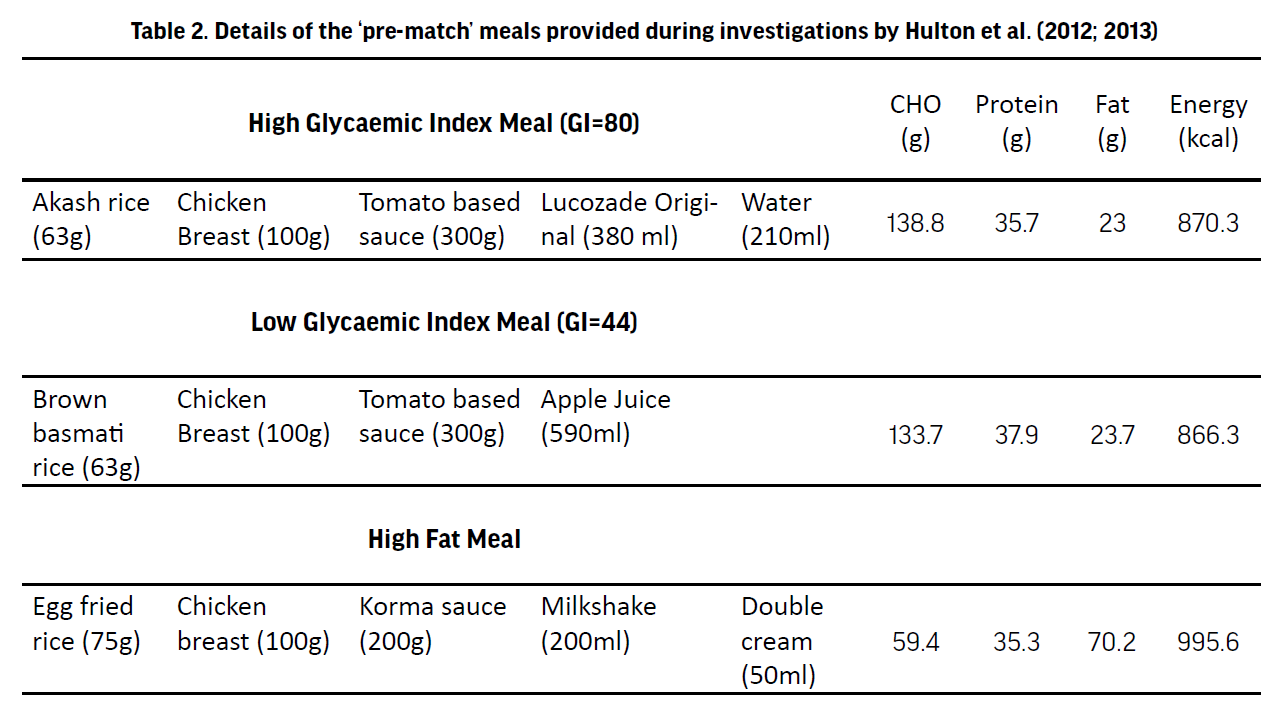
Nutrition and match-day: during match
In order to maintain adequate hydration, muscle glycogen and blood glucose concentrations, sufficient intake of CHO and fluid are the main nutritional considerations during match-play. Data from laboratory-based studies shows that CHO ingestion during soccer-specific exercise augments plasma glucose availability and maintains rates of CHO oxidation (Clarke et al., 2008). However, given the acyclic nature of activity in soccer, there are no scheduled breaks where fluid can be consumed; besides, gastric tolerance and the perception of gut fullness do not allow for suitable rehydration for soccer players. Furthermore, Leiper et al. (2205) demonstrated that the intensity corresponding to that of a soccer match is sufficient to slow gastric emptying. Therefore, due to the continuous nature of play, with infrequent, unscheduled stoppages, the only two occasions that a player is guaranteed to be able to consume fluid are before the game and at half-time. It is therefore prudent that players take on board fluid during and additional breaks in play e.g. injury stoppages.
The intensity of exercise associated with a competitive match is high enough to induce appreciable heat load, causing players to lose up to 3 L of sweat during a match (Ekblom, 1986). Therefore, as a guide, players should aim to drink sufficient fluids to prevent a deficit of no more than 2–3% of pre-match euhydrated body mass (ACSM, 2007). The addition of CHO to this fluid can further improve exercise capacity (Nicholas et al., 1995), possibly due to prevention of hypoglycaemia, maintenance of high CHO oxidation rates, glycogen sparing and effects on the central nervous system delaying the onset of fatigue (Leatt & Jacobs, 1989). Consequently, a CHO intake at a rate of 30–60 g/h has been associated with a consistent beneficial effect on performance in soccer (Baker et al., 2015). However, players in the English Premier League reported a CHO intake of 32 g/h just before and during a match (Anderson et al., 2017).
The ingestion of CHO has frequently resulted in improvements in exercise capacity during the performance of exercise protocols that simulate the work-rate of soccer (Clarke et al., 2005) and actual match-play (Kirkendall et al., 1988), although sprint performance is less consistent. However, soccer performance is not only dependent on physical performance. Motor skills and cognitive performances also play a crucial role and there is a tendency for players’ skills and cognitive performance to decline during the latter stages of a match (Oliveira et al., 2017). Carbohydrate has been shown to attenuate, or even eliminate, this detrimental effect over the course of a match (Ali & Williams, 2009). For example, Harper and colleagues (2017) reported that a CHO–electrolyte solution improved dribbling speed during the later stages of a soccer match simulation. Furthermore, CHO supplementation attenuated the decrements in shooting (Russell et al., 2012) and passing (Ali & Williams, 2009) performance during simulated soccer match-play. Furthermore, the co-ingestion of a 6% CHO solution with the addition of 160 mg/L of caffeine has been reported to improve sprinting performance and countermovement jumping (Gant et al., 2010), in addition to reductions in perceived exertion following a normal high CHO feeding strategy with the co-ingestion of 5 mg/kg of caffeine prior to a simulated soccer protocol (Hulton et al., 2020). A further interesting development is that caffeinated gum containing 200 mg of caffeine (2 x 100 mg pieces of gum) prior to soccer-specific tests has been reported to enhance the yo-yo intermittent recovery test as well as countermovement jumping performance by approximately 2%, although further research is warranted (Ranchordas et al., 2018).
It should also be noted that matches can extend to extra time and penalty shoot-outs. As previously mentioned (Harper et al., 2015), it was reported that ingestion of a CHO–electrolyte gel before a simulated extra-time period raised blood glucose concentrations and improved dribbling performance during the extra-time period of simulated soccer match-play. Finally, CHO mouth rinse has been shown to increase self-selected jogging speed with likely benefits for repeated 15 m sprint performance (Rollo et al., 2015). Therefore, CHO mouth rinsing prior to extra-time or penalty shootout could potentially enhance performance in situations where CHO consumption is limited by gastrointestinal concerns.
Match-day: post-match
Due to the depletion of muscle and liver glycogen during match-play, the main focus for recovery is to replenish these stores in addition to rehydrating and ensuring muscle protein is recovered. Normally, this should be achieved within a 2-h window after a match (Ivy et al., 1988) and is especially important if fixtures are close together i.e. within 2-3 days or so. This limited time frame for glycogen resynthesis is due to exercise-induced glycogen depletion promoting activation of glycogen synthase (Wojtaszewski et al., 2001), exercise-induced increases in insulin sensitivity (Richter et al., 1989), and exercise sensitisation of muscle cell membranes to glucose delivery (Burke et al., 2004). Therefore, the sooner the CHO intake after exercise the better. Those players who are unable to consume adequate CHO following a match risk a reduced ability to resynthesise glycogen by approximately 50% throughout a 4-h period, regardless of consuming CHO 2-hours following the cessation of exercise (Ivy et al., 1988). In the same fashion as MD-1 when the nutritional goal is to maximise glycogen synthesis, HGI CHO are the variety of choice to enhance the replenishment over the LGI equivalent (Burke et al., 1993), with an ideal intake of approximately 1.0–1.2g/kg/h to achieve this (Burke et al., 2004). If sufficient CHO cannot be ingested in the immediate post-match period, there is some evidence that additional protein may help glycogen resynthesis. Thereby, if the recommended intake of 1.2 g/kg/hr is unable to be attained, then an additional amount of 0.4g/kg/h of protein could ensure adequate rates of glycogen storage (van Loon et al., 2000).
In addition to the use of protein to support muscle glycogen replenishment, it is a vital component of nutritional recovery due to the muscle protein breakdown that will occur during match play. Previous understanding suggested that 20 g of protein provided no greater advantage over 40 g during the recovery period following resistance exercise (Witard et al., 2014). However, this was observed following a bout of unilateral exercise and not full body exercise, which may be more comparable to football. MacNaughton and colleagues (2016) thereby conducted a similar investigation following whole body resistance exercise and found that 40 g stimulates a greater myofibrillar protein synthesis response than 20 g in young resistance-trained men, irrespective of their lean body mass. Solid or whole foods rich is protein would generally be recommended, but whey protein shakes are often favoured as a more expedient way to consume protein, with appetite sometimes suppressed following exercise. Whey protein is recommended over casein and soy protein due to its rapid absorption, and importantly it’s high proportion of leucine (Tang et al., 2009), which is a key amino acid that at high doses can stimulate muscle protein synthesis.
Another important aspect of recovery from match play is rehydration. Players can be hyperthermic at the final whistle and sweat losses can exceed 3 to 4 L (Maughan & Shirreffs, 2007). Therefore, the goal post-match is to replace any fluid and electrolyte deficit. As players should be consuming regular foods during recovery that contain sodium, plain water should suffice (ACSM, 2007). However, if sodium is not present or insufficient, this will delay a return to a euhydrated state due to the stimulation of urine production, and it may be recommended to intake formulated sports drinks for their added electrolyte content. As an approximate recommended intake to achieve rehydration quickly, 150% of weight loss or 1.5 L per 1 kg of weight lost may be suggested (Shirreffs & Maughan, 1998), which would support the fluid loss and account for any urination that ensues. Furthermore, it is key not to hyperhydrate post-match, especially following evening matches, as sleep disturbances in athletes has been attributed to waking throughout the night to urinate (Halson, 2008). Therefore, milk may be a drink of choice prior to bedtime, not only for the protein and casein content, but due to its high electrolyte content compared to water (Roy, 2008).
Due to the nature of the game at professional levels, many substitutes are available for selection at various times. These players are required to load up on fluid and carbohydrates in the same manner as those starting the match. However, if they play only a few minutes or not at all, then it is strongly advisable not to engage in the high CHO eating strategies outlined above. Rather, these players should focus on low-carbohydrate, high-protein foods both in the changing room and for their post-match meal. Failure to do so over repetitive matches is likely to lead to increases in body fat due to the conversion of the excess CHO ingested into fat. Table 3 below provides some suggestions for foods and drink to consume post-match.
Day after match day (MD+1)
A day that is sometimes forgotten, or at least not treated with the same nutritional respect, is MD+1. Yet nutritional importance is paramount, as players may still be in an energy deficit and need to consume appropriate CHO to continue their refuelling strategy in preparation for the forthcoming training week and match/es. Early work conducted by Jacobs and colleagues (1982) with elite Swedish players highlighted that insufficient CHO intake due to poor dietary habits following a competitive fixture limited post-match glycogen replenishment. They observed values that were typically lower than sedentary individuals 48-h post-match. Furthermore, the importance of MD+1 is emphasised further during periods of fixture congestion, which demonstrate increased volume and intensity of activity due to match-play (Anderson et al., 2017). Therefore, a continuation of high CHO intake is advised on MD+1 since this will continue to top-up muscle glycogen as well as liver glycogen stores.
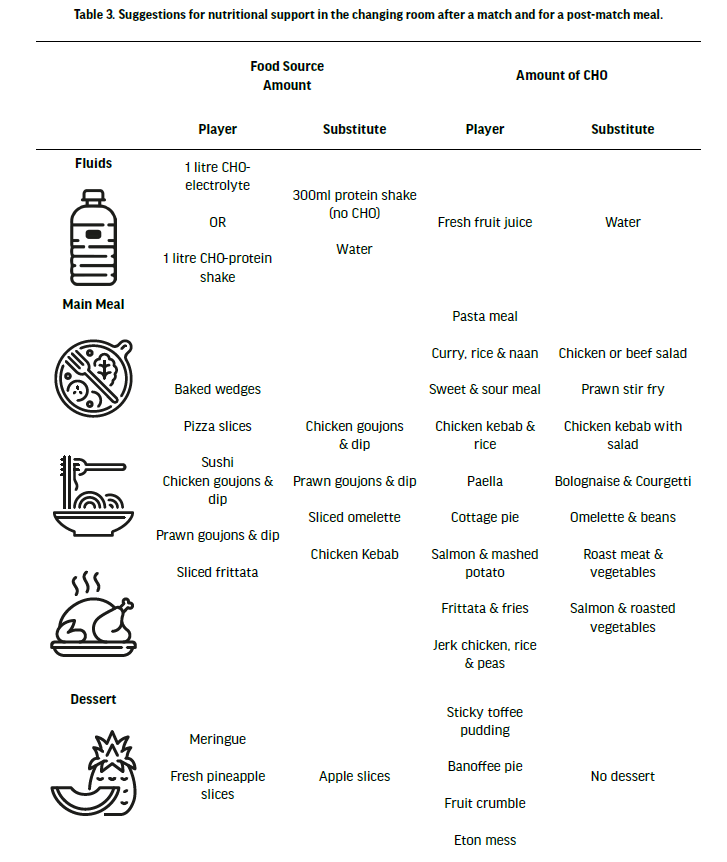
However, recent investigations (Gunnarsson et al., 2013) have shown that glycogen resynthesis may not be equal in both fibre types, with an impairment observed in type II fibres 48-h post simulated match play. This was despite players following a high CHO diet supplemented with whey protein, strengthening the rationale for the continuation of high CHO for complete recovery. The muscle damaging effects of eccentric exercise, characterised in soccer by dynamic changes of direction and high intensity accelerations and decelerations, are suggested to cause the impairment in glycogen resynthesis seen in type II fibres (Zehnder et al., 2004). Therefore, in order to overcome these impairments, soccer players are advised to maintain a high CHO diet during the first 24-h following competition. For this purpose, it is suggested that around 6–8g/kg is continued (Collins et al., 2021). Supplementing the CHO diet with protein has already been discussed (van Loon et al., 2000) and can be advantageous. Further nutritional strategies to support replenishment could be supported with the addition of creatine. Research suggests that 20 g/day of creatine monohydrate with each CHO-containing drink over successive days may provide further provision to increase muscle glycogen alongside a high CHO diet (Roberts et al., 1988). In this study, improvements in glycogen replenishment were observed 24-h post-exercise and over 6 days of feeding, thereby reinforcing the use of creatine to further augment muscle glycogen storage as part of the recovery strategy.
Conclusions
In light of the evidence presented on match-day and recovery, Figure 2 below showcases the nutritional needs and timings around this competition day, capturing all the important timepoints to consume food or drink prior to the match, during the match and for immediate post-match recovery.
However, the dietary habits of a soccer player need to meet the demands of the training and preparation for match-day as well as a full recovery. Research highlighted in the current review suggests that soccer players consume appropriate amounts of protein, but the periodisation of CHO intake may be lacking. Consequently, the need for optimal nutritional intake throughout the competitive season is imperative for peak performance. The communication between the multidisciplinary team within a soccer club is important to ensure that players are fuelling correctly for each training session, the build up to competition, and not forgetting total recovery.
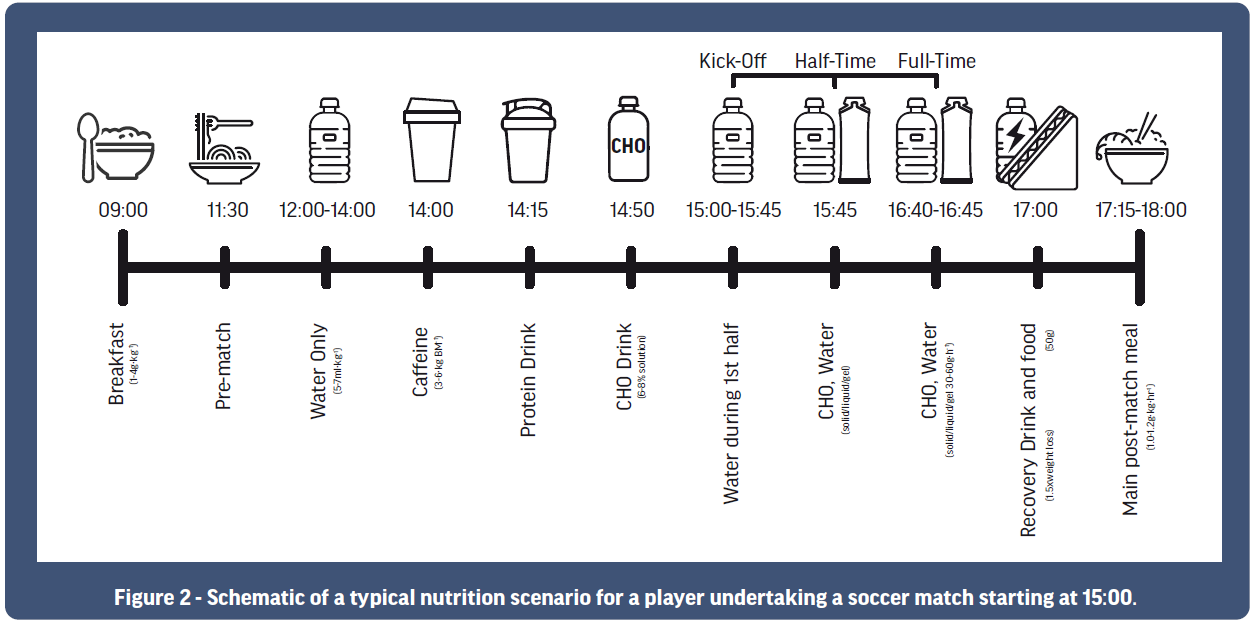
References
- Ali, A.; Williams, C.; Nicholas, C.W.; Foskett, A. (2007) The influence of carbohydrate-electrolyte ingestion on soccer skill performance. Med Sci Sports Exerc. 39: 1969-76.
- Ali, A.; Williams, C. (2009). Carbohydrate ingestion and soccer skill performance during prolonged intermittent exercise. J Sports Sci. 27:1499-508.
- American College of Sports Medicine, Sawka, M.N.; Burke, L.M.; Eichner, E.R.; Maughan, R.J.; Montain, S.J.; Stachenfeld, N.S. (2007). American College of Sports Medicine position stand. Exercise and fluid replacement. Med Sci Sports Exerc. 39: 377-
90. - Anderson, L.; Orme, P.; Naughton, R.J.; Close, G.L.; Milsom, J.; Rydings, D.; O'Boyle, A.; Di Michele, R.; Louis, J.; Hambly, C.; Speakman, J.R.; Morgans, R.; Drust, B.; Morton, J.P. (2017). Energy Intake and Expenditure of Professional Soccer Players of the English Premier League: Evidence of Carbohydrate Periodization. Int J Sport Nutr Exerc Metab. 27: 228-
238. - Backhouse, S.H.; Ali, A.; Biddle, S.J.H.; Williams, C. (2007). Carbohydrate ingestion during prolonged high-intensity intermittent exercise: impact on affect and perceived exertion. Scand J Med Sci Sports, 17:605-10.
- Balsom, P.D. Wood, K.; Olsson, P.; Ekblom, B. (1999). Carbohydrate intake and multiple sprint sports: with special reference to football (soccer). Int J Sports Med. 20: 48-52.
- Bangsbo J. (1994). Energy demands in competitive soccer. J Sports Sci. 12: S5–12.
- Bangsbo, J. (2014). Physiological Demands of Football. Sport Sci Exch. 27: 1–6. Available from: https://secure.footprint.net/gatorade/stg/gssiweb/pdf/SSE125_Bangsbo.pdf%5Cnpapers2://publication/uuid/D03728B2-A407-4AEC-824E-7FDADC4E099B
- Bangsbo, J.; Norregaard, L.; Thorsoe, F. (1992). The effect of carbohydrate diet on intermittent
exercise performance. Int J Sports Med.;3: 152–7. - Barnes, C.; Archer, D.T.; Hogg, B.; Bush, M.; Bradley, P.S. (2014). The evolution of physical and technical performance parameters in the English Premier League. Int J Sports Med. 35: 1095–1100.
- Bloomfield, J.; Polman, R.; O’Donoghue, P. Physical demands of different positions in FA Premier League soccer. J Sport Sci Med. 2007;6:63–70.
- Bradley, P.S.; Sheldon, W.; Wooster, B.; Olsen, P.; Boanas, P.; Krustrup, P. (2009). High-intensity running in English FA Premier League soccer matches. J Sports Sci. 27: 159–68.
- Briggs, M.A.; Cockburn, E.; Rumbold, P.L.S.; Rae, G.; Stevenson, E.J.; Russell, M. (2015). Assessment of energy intake and energy expenditure of male adolescent academy-level soccer players during a competitive week. Nutrients. 7: 392–401.
- Brinkmans, N.Y.J.; Iedema, N.; Plasqui, G.; Wouters, L.; Saris, W.H.M.; van Loon, L.J.C.; van Dijk, J.W. (2019). Energy expenditure and dietary intake in professional football players in the Dutch Premier League: Implications for nutritional counselling. J Sports Sci. 37: 2759-2767.
- Burke, L.M.; Collier, G.R.; Hargreaves, M.(1985). Muscle glycogen storage after prolonged exercise: effect of the glycemic index of carbohydrate feedings. J Appl Physiol 75: 1019-23.
- Burke, L.M.; Kiens, B.; Ivy, J.L. (2004). Carbohydrates and fat for training and recovery. J Sports Sci. 22: 15-30.
- Casey, A.; Mann, R.; Banister, K.; Fox, J.; Morris, P.G.; Macdonald, I.A.; Greenhaff, P.L. (2000). Effect of carbohydrate ingestion on glycogen resynthesis in human liver and skeletal muscle, measured by (13)CMRS. Am J Physiol Endocrinol Metab. 278: E65-75.
- Christensen, E.H.; Hansen, O. (1939). Arbeitsfahigkeit und Ern ¨ arung. ¨ Skandinavishes Archiv fur Physiolgie ¨81, 160–171.
- Clarke, N.D.; Drust, B.; MacLaren, D.P.; Reilly, T.(2005). Strategies for hydration and energy provision during soccer-specific exercise. Int J Sport Nutr Exerc Metab. 15: 625-40.
- Clarke, N.D.; Drust, B.; Maclaren, D.P.; Reilly, T. (2008). Fluid provision and metabolic responses to soccer-specific exercise. Eur J Appl Physiol. 104: 1069-77.
- Clemente, F.; Owen, A.; Serra-Olivares, J.; Nikolaidis, P.; van der Linden, C.; Mendes, B. (2019). Characterization of the weekly external load profile of professional soccer teams from Portugal and the Netherlands. J Hum Kinet. 66:155.
- Collins, J.; Maughan, R.J.; Gleeson, M.; Bilsborough, J.; Jeukendrup, A.; Morton, J.P.; Phillips, S.M.; Armstrong, L.; Burke, L.M.; Close, G.L.; Duffield, R.; Larson-Meyer, E.; Louis, J.; Medina, D.; Meyer, F.; Rollo, I.; Sundgot-Borgen, J.; Wall, B.T.; Boullosa, B.; Dupont, G.; Lizarraga, A.; Res, P.; Bizzini, M.; Castagna, C.; Cowie, C.M.; D'Hooghe, M.; Geyer, H.; Meyer, T.; Papadimitriou, N.; Vouillamoz, M.; McCall, A. UEFA expert group statement on nutrition in elite football. Current evidence to inform practical recommendations and guide future research. Br J Sports Med. 2021 Apr;55(8):416. doi: 10.1136/bjsports-2019-101961. Epub 2020 Oct 23. PMID: 33097528.
- Currell, K.; Conway, S.; Jeukendrup, A.E. Carbohydrate ingestion improves performance of a new reliable test of soccer performance. Int J Sport Nutr Exerc Metab. 2009 Feb;19(1):34-46. doi: 10.1123/ijsnem.19.1.34. PMID: 19403952.
- DeMarco, H.M.; Sucher, K.P.; Cisar, C.J.; Butterfield, G.E. Pre-exercise carbohydrate meals: application of glycemic index. Med Sci Sports Exerc. 1999 Jan;31(1):164-70. doi: 10.1097/00005768-199901000-00025. PMID: 9927025.
- Duvnjak-Zaknich, D.M.; Dawson, B.T.; Wallman, K.E.; Henry, G. Effect of caffeine on reactive agility time when fresh and fatigued. Med Sci Sports Exerc. 2011 Aug;43(8):1523-30. doi: 10.1249/MSS.0b013e31821048ab. PMID: 21266929.
- Ellis, M.; Noon, M.; Myers, T.; Clarke, N. Low Doses of Caffeine: Enhancement of Physical Performance in Elite Adolescent Male Soccer Players. Int J Sports Physiol Perform. 2019 May 1;14(5):569-575. doi: 10.1123/ijspp.2018-0536. Epub 2019 Apr 21. PMID: 30300047.
- Ekblom, B. Applied physiology of soccer. Sports Med. 1986 Jan-Feb;3(1):50-60. doi: 10.2165/00007256-198603010-00005. PMID: 3633120.
- Faude, O.; Koch, T.; Meyer, T. Straight sprinting is the most frequent action in goal situations in professional football. J Sports Sci. 2012;30:625–31.
- Foskett, A.; Ali, A.; Gant, N. Caffeine enhances cognitive function and skill performance during simulated soccer activity. Int J Sport Nutr Exerc Metab. 2009 Aug;19(4):410-23. doi: 10.1123/ ijsnem.19.4.410. PMID: 19827465.
- Gant, N.; Ali, A.; Foskett, A. The influence of caffeine and carbohydrate coingestion on simulated soccer performance. Int J Sport Nutr Exerc Metab. 2010 Jun;20(3):191-7. doi: 10.1123/ijsnem.20.3.191. PMID: 20601736.
- Gunnarsson, T.P.; Bendiksen, M.; Bischoff, R.; Christensen, P.M.; Lesivig, B.; Madsen, K.; Stephens, F.; Greenhaff, P.; Krustrup, P.; Bangsbo, J. Effect of whey protein- and carbohydrat eenriched diet on glycogen resynthesis during the first 48 h after a soccer game. Scand J Med Sci Sports. 2013 Aug;23(4):508-15. doi: 10.1111/j.1600- 0838.2011.01418.x. Epub 2011 Nov 23. PMID: 22107250.
- Halson, S.L. Nutrition, sleep and recovery, Eur J Sport Sci (2008), 8:2, 119-126, DOI:10.1080/17461390801954794
- Harper, L.D.; Briggs, M.A.; McNamee, G.; West, D.J.; Kilduff, L.P.; Stevenson, E.; Russell, M. Physiological and performance effects of carbohydrate gels consumed prior to the extra-time period of prolonged simulated soccer match-play. J Sci Med Sport. 2016 Jun;19(6):509-14. doi: 10.1016/j. jsams.2015.06.009. Epub 2015 Jun 17. PMID: 26115589.
- Harper, L.D.; Stevenson, E.J.; Rollo, I.; Russell, M. The influence of a 12% carbohydrate electrolyte beverage on self-paced soccer-specific exercise performance. J Sci Med Sport. 2017 Dec;20(12):1123-1129. doi: 10.1016/j.jsams.2017.04.015. Epub 2017 Apr 21. PMID: 28483560.
- Hson Nilsson, L. Liver Glycogen Content in Man in the Postabsorptive State, Scand J Clin Lab Inv (1973), 32:4, 317-323, DOI:
10.3109/00365517309084354. - Hulton, A.T.; Gregson, W.; Maclaren, D.; Doran, D.A. Effects of GI meals on intermittent exercise. Int J Sports Med. 2012 Sep;33(9):756-62. doi: 10.1055/s0031-1299754. Epub 2012 Jun 15. PMID: 22706944.
- 37. Hulton, A.T.; Edwards, J.P.; Gregson, W.; Maclaren, D.; Doran, D.A. Effect of fat and CHO meals on intermittent exercise in soccer players. Int J Sports Med. 2013 Feb;34(2):165-9. doi: 10.1055/s-0032-1321798. Epub 2012 Sep 12. PMID: 22972250.
- Hulton, A.T.; Vitzel, K.; Doran, D.A.; MacLaren, D.P.M. Addition of Caffeine to a Carbohydrate Feeding Strategy Prior to Intermittent Exercise. Int J Sports Med. 2020 Aug;41(9):603-609. doi: 10.1055/a-1121-7817.
- Hulton, A. T., Malone, J. J., Clarke, N. D., & Maclaren, D. P. M. (2022). Energy Requirements and Nutritional Strategies for Male Soccer Players: A Review and Suggestions for Practice. Nutrients, 14(3), [657]. https://doi.org/10.3390/nu1403065740.
- Iaia, F.M.; Rampinini E.; Bangsbo, J. High-Intensity Training in Football. Int J Sports Physiol Perform. 2009;4:291–306.
- Ivy, J.L.; Katz, A.L.; Cutler, C.L.; Sherman, W.M.; Coyle, E.F. Muscle glycogen synthesis after exercise: effect of time of carbohydrate ingestion. J Appl Physiol (1985). 1988 Apr;64(4):1480-5. doi: 10.1152/jappl.1988.64.4.1480. PMID: 3132449.
- Jacobs, I.; Westlin, N.; Karlsson, J.; Rasmusson, M.; Houghton, B. Muscle glycogen and diet in elite soccer players. Eur J Appl Physiol Occup Physiol. 1982;48(3):297-302. doi: 10.1007/BF00430219. PMID: 7200872.
- Kirkendall, D.T.; Foster, C.; Dean, J.A.; Grogan, J.; Thompson, N.N. 1988. Effect of glucose polymer supplementation on performance of soccer players. In: Reilly T, Lees A, Davids K, and Murphy WJ. (ed.) Science and Football. London: E & FN SPON.
- Krustrup, P.; Mohr, M.; Ellingsgaard, H.; Bangsbo, J. Physical demands during an elite female soccer game: Importance of training status. Med Sci Sports Exerc. 2005;37:1242–8.
- Krustrup, P.; Mohr, M.; Steensberg, A.; Bencke, J.; Klær, M.; Bangsbo, J. Muscle and blood metabolites during a soccer game: Implications for sprint performance. Med Sci Sports Exerc. 2006;38:1165–74.
- Krustrup, P.; Ortenblad, N.; Nielsen, J.; Nybo, L.; Gunnarsson, T.P.; Iaia, F.M.; Madsen, K.; Stephens, F.; Greenhaff, P.; Bangsbo, J. Maximal voluntary contraction force, SR function and glycogen resynthesis during the first 72 h after a high-level competitive soccer game. Eur J Appl Physiol. 2011 Dec;111(12):2987-95. doi: 10.1007/s00421-011-1919-y. Epub 2011 Mar 30. PMID: 21448723.
- Leatt, P.B.; Jacobs, I. Effect of glucose polymer ingestion on glycogen depletion during a soccer match. Can J Sport Sci. 1989 Jun;14(2):112-6. PMID: 2736440.
- Leiper, J.B.; Nicholas, C.W.; Ali, A.; Williams, C.; Maughan, R.J. The effect of intermittent high-intensity running on gastric emptying of fluids in man. Med Sci Sports Exerc. 2005 Feb;37(2):240-7. doi: 10.1249/01.mss.0000152730.74596.50. PMID: 15692319.
- Little, J.P.; Chilibeck, P.D.; Ciona, D.; Vandenberg, A.; Zello, G.A. The effects of low- and high-glycemic index foods on high-intensity intermittent exercise. Int J Sports Physiol Perform. 2009 Sep;4(3):367-80. doi: 10.1123/ijspp.4.3.367. PMID: 19953824.
- Little, J.P.; Chilibeck, P.D.; Ciona, D.; Forbes, S.; Rees, H.; Vandenberg, A.; Zello, G.A. Effect of low- and high-glycemic-index meals on metabolism and performance during high-intensity, intermittent exercise. Int J Sport Nutr Exerc Metab. 2010 Dec;20(6):447-56. doi: 10.1123/ijsnem.20.6.447. PMID: 21116017.
- Macnaughton, L.S.; Wardle, S.L.; Witard, O.C.; McGlory, C.; Hamilton, D.L.; Jeromson, S.; Lawrence, C.E.; Wallis, G.A.; Tipton, K.D. The response of muscle protein synthesis following whole-body resistance exercise is greater following 40 g than 20 g of ingested whey protein. Physiol Rep. 2016 Aug;4(15):e12893. doi: 10.14814/phy2.12893. PMID: 27511985; PMCID: PMC4985555.
- Malone, J.J.; Di Michele, R.; Morgans, R.; Burgess, D.; Morton, J.P.; Drust, B. Seasonal training-load quantification in elite English Premier League soccer players. Int J Sports Physiol Perform. 2015;10:489–97.
- Malone, J.J.; Hulton, A.T.; MacLaren, D.P.M. Exogenous carbohydrate and regulation of muscle carbohydrate utilisation during exercise. Eur J Appl Physiol. 2021;121(5):1255-1269. doi: 10.1007/s00421-021-04609-4. Epub 2021 Feb 5. PMID: 33544230; PMCID: PMC8064975.
- Maughan, R.J. Energy and macronutrient intakes of professional football (soccer) players. Br J Sports Med. 1997;31:45–7.
- Maughan, R.J.; Shirreffs, S.M. Nutrition for soccer players. Current Sports Medicine Reports. 2007; 6:279-280.
- Mohr, M.; Krustrup, P.; Bangsbo, J. Match performance of high-standard soccer players with special reference to development of fatigue. J Sports Sci. 2003;21:519–28.
- Mohr, M.; Krustrup, P.; Bangsbo, J. Fatigue in soccer: a brief review. J Sports Sci. 2005 Jun;23(6):593-9. doi: 10.1080/02640410400021286. PMID: 16195008.
- Mujika, I.; Burke, L.M. Nutrition in team sports. Ann Nutr Metab. 2010;57 Suppl 2:26-35. doi: 10.1159/000322700
- Nicholas, C.W.; Williams, C.; Lakomy, H.K.; Phillips, G.; Nowitz, A. Influence of ingesting a carbohydrate-electrolyte solution on endurance capacity during intermittent, high-intensity shuttle running. J Sports Sci. 1995 Aug;13(4):283-90. doi: 10.1080/02640419508732241. PMID: 7474041.
- Oliveira, C.C.; Ferreira, D.; Caetano, C.; Granja, D.; Pinto, R.; Mendes, B.; Sousa, M. Nutrition and Supplementation in Soccer. Sports (Basel). 2017 May 12;5(2):28. doi: 10.3390/sports5020028. PMID: 29910389; PMCID: PMC5968974.
- Phillips, S.M. A brief review of critical processes in exercise-induced muscular hypertrophy. Sports Med. 2014;44 Suppl 1(Suppl 1):S71-7. doi: 10.1007/s40279-014-0152-3. PMID: 24791918; PMCID: PMC4008813.
- Ranchordas, M.K.; King, G.; Russell, M.; Lynn, A.; Russell, M. Effects of Caffeinated Gum on a Battery of Soccer-Specific Tests in Trained University-Standard Male Soccer Players. Int J Sport Nutr Exerc Metab. 2018 Nov 1;28(6):629-634. doi: 10.1123/ijsnem.2017-0405. Epub 2018 Sep 3. PMID: 29584462.
- Reilly, T. (1996). Science and Soccer. London: E&FN Spon.
- Richter, E.A.; Mikines, K.J.; Galbo, H.; Kiens, B. Effect of exercise on insulin action in human skeletal muscle. J Appl Physiol (1985). 1989 Feb;66(2):876-85. doi: 10.1152/jappl.1989.66.2.876. PMID: 2496078.
- Roberts, K.M.; Noble, E.G.; Hayden, D.B.; Taylor, A.W. Simple and complex carbohydrate-rich diets and muscle glycogen content of marathon runners. Eur J Appl Physiol Occup Physiol. 1988;57(1):70-4. doi: 10.1007/BF00691241. PMID: 3342797.
- Rollo, I.; Homewood, G.; Williams, C.; Carter, J.; Goosey-Tolfrey, V.L. The Influence of Carbohydrate Mouth Rinse on Self-Selected Intermittent Running Performance. Int J Sport Nutr Exerc Metab. 2015 Dec;25(6):550-8. doi: 10.1123/ijsnem.2015-0001. Epub 2015 Jun 9. PMID: 26061762.
- Roy, B.D. Milk: the new sports drink? A Review. J Int Soc Sports Nutr. 2008 Oct 2;5:15. doi: 10.1186/1550-2783-5-15. PMID: 18831752; PMCID: PMC2569005.
- Russell, M.; Benton, D.; Kingsley, M. Influence of carbohydrate supplementation on skill performance during a soccer match simulation. J Sci Med Sport. 2012 Jul;15(4):348-54. doi: 10.1016/j. jsams.2011.12.006. Epub 2012 Jan 9. PMID: 22230353.
- Saltin, B. Substrate metabolism of the skeletal musculature during exercise. 5. Muscle glycogen]. Lakartidningen. 1972 Mar 29;69(14):1637-40. PMID: 5024088.
- Shirreffs, S.M.; Maughan, R.J. Volume repletion after exercise-induced volume depletion in humans: replacement of water and sodium losses. Am J Physiol. 1998 May;274(5):F868-75. doi: 10.1152/ajprenal.1998.274.5.F868. PMID: 9612323.
- Souglis, A.G.; Chryssanthopoulos, C.I.; Travlos, A.K.; Zorzou, A.E.; Gissis, I.T.; Papadopoulos, C.N.; Sotiropoulos, A.A. The effect of high vs. low carbohydrate diets on distances covered in soccer. J Strength Cond Res. 2013 Aug;27(8):2235-47. doi: 10.1519/JSC.0b013e3182792147. PMID: 23168373.
- Tang, J.E.; Moore, D.R.; Kujbida, G.W.; Tarnopolsky, M.A.; Phillips, S.M. Ingestion of whey hydrolysate, casein, or soy protein isolate: effects on mixed muscle protein synthesis at rest and following resistance exercise in young men. J Appl Physiol (1985). 2009 Sep;107(3):987-92. doi: 10.1152/japplphysiol.00076.2009. Epub 2009 Jul 9. PMID: 19589961.
- Thomas, D.E.; Brotherhood, J.R.; Brand, J.C. Carbohydrate feeding before exercise: effect of glycemic index. Int J Sports Med. 1991 Apr;12(2):180-6. doi: 10.1055/s-2007-1024664. PMID: 1860741.
- Tipton, K.D.; Elliott, T.A.; Cree, M.G.; Aarsland, A.A.; Sanford, A.P.; Wolfe, R.R. Stimulation of net muscle protein synthesis by whey protein ingestion before and after exercise. Am J Physiol Endocrinol Metab. 2007 Jan;292(1):E71-6. doi: 10.1152/ajpendo.00166.2006. Epub 2006 Aug 8. PMID: 16896166.
- van Loon, L.J.; Kruijshoop, M.; Verhagen, H.; Saris, W.H.; Wagenmakers, A.J. Ingestion of protein hydrolysate and amino acid-carbohydrate mixtures increases postexercise plasma insulin responses in men. J Nutr. 2000 Oct;130(10):2508-13. doi: 10.1093/
jn/130.10.2508. PMID: 11015482. - Wee, S.L.; Williams, C.; Tsintzas, K.; Boobis, L. Ingestion of a high-glycemic index meal increases muscle glycogen storage at rest but augments its utilization during subsequent exercise. J Appl Physiol (1985). 2005 Aug;99(2):707-14. doi: 10.1152/japplphysiol.01261.2004. Epub 2005 Apr 14. PMID: 15831796.
- Witard, O.C.; Jackman, S.R.; Breen, L.; Smith, K.; Selby, A.; Tipton, K.D. Myofibrillar muscle protein synthesis rates subsequent to a meal in response to increasing doses of whey protein at rest and after resistance exercise. Am J Clin Nutr. 2014 Jan;99(1):86-95. doi: 10.3945/ajcn.112.055517. Epub 2013 Nov 20. PMID: 24257722.
- Wojtaszewski, J.F.; Nielsen, P.; Kiens, B.; Richter, E.A. Regulation of glycogen synthase kinase-3 in human skeletal muscle: effects of food intake and bicycle exercise. Diabetes. 2001 Feb;50(2):265-9. doi: 10.2337/diabetes.50.2.265. Erratum in: Diabetes. 2003 Sep;52(9):2449. Wojtazsewski J F [corrected to Wojtaszewski J F]. PMID: 11272135.
- Wong, S.H.S.; Siu, P.M.; Lok, A.; Chen, Y.J.; Morris, J.; Lam, C.W. Effect of the glycaemic index of pre-exercise carbohydrate meals on running performance, Eur J Sport Sci (2008), 8:1, 23-33, DOI: 10.1080/17461390701819451
- Zehnder, M.; Muelli, M.; Buchli, R.; Kuehne, G.; Boutellier, U. Further glycogen decrease during early recovery after eccentric exercise despite a high carbohydrate intake. Eur J Nutr. 2004 Jun;43(3):148-59. doi: 10.1007/s00394-004-0453-7. Epub 2004 Jan 6.
PMID: 15168037.


